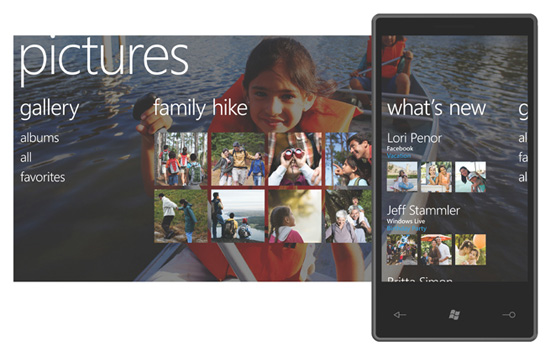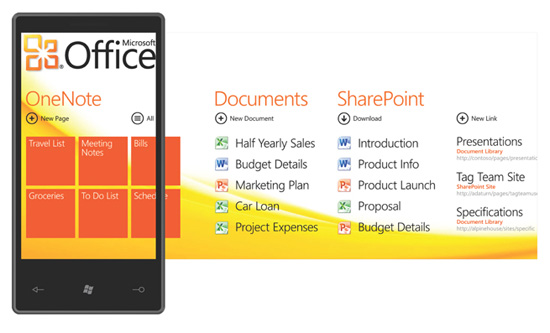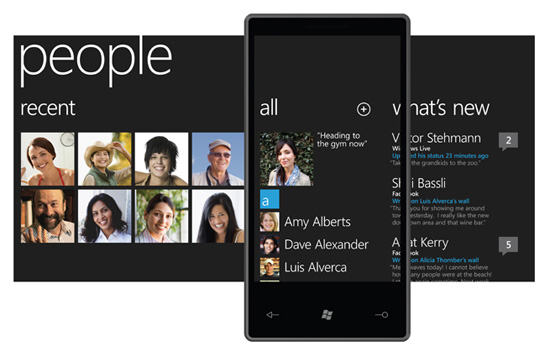
Original Link: https://www.anandtech.com/show/2946
Windows Phone 7 Series Takeaway
by Brian Klug on February 22, 2010 12:00 PM EST- Posted in
- Smartphones
- Mobile
2 years, 9 months and 15 days. That's how long it's been since Microsoft CEO Steve Ballmer shrugged off the competition during an interview after the iPhone's public unveiling, until the announcement of Windows Phone 7 Series at Mobile World Congress. Since then, the smartphone market has rapidly evolved, and Windows Mobile has seen fierce and rapidly evolving competition. We've seen the introduction of two major revisions of Android and iPhone OS, incremental OS updates from RIM with BlackBerry OS, and full-on platform reboots from both Palm and Nokia. All the while, Windows Mobile has remained relatively the same, receiving subtle updates and slowly slipping from being a dominant player with almost 40% market share, to an increasingly marginalized platform showing serious age.
It isn't much of a leap to see how much a complete platform reboot was needed.
Although the details that have been revealed thus far are relatively scant, it's safe to say one thing - Phone 7 Series is Microsoft's attempt to wipe its mobile platform of Pocket PC heritage, and instead rebuild with a new UI paradigm that does away entirely with the old. Gone are the throwbacks to Windows CE: its stylus driven interface, task manager, implicit multitasking, and start menu.
Instead, they've been replaced with something radically different and refreshing for Microsoft. The Phone 7 Series UI has taken nods from the typographically-driven user interfaces that Microsoft has designed in the past and given it the capacitive multitouch treatment. The Zune HD interface is what most point to (and rightfully so), but this typography-dominated style actually traces all the way back to the interface designed for Windows Media Center, and even borrows UI elements from the NXE Xbox dashboard, according to Windows Phone Program Management Joe Belfiore. Microsoft calls this style codename "Metro."

Although we haven't seen all of it yet, software is grouped into "Hubs." Microsoft has shown People, Pictures, Games, Music + Video, Marketplace, and Office very prominently as examples. The usual suspects are also present: Phone, SMS, Calendar, Email, Internet Explorer, and Bing search + maps. All of these applications have been given a hearty helping of "metro" design; simple rectangular shapes of color on a black background for a relatively spartan yet invitingly simple appearance. By their own admission, much of the experience still isn't fleshed out in its entirety, and placeholders still abound. But Microsoft is being forthcoming here by noting that much more will be shown at MIX10.
A chief UI differentiator is the integration of what Microsoft is calling "tiles." Instead of adopting a strictly unitasking workflow, Microsoft hopes to leverage inactive display by using tiles that reflect constantly updated data. Although details are scarce regarding how much freedom developers will have with what can be shown, this functionality is essentially expected to mitigate the platform's lack of traditional multitasking.
Microsoft believes so strongly in this UI that they're disallowing modification to it by both carriers and manufacturers.
Lessons From Windows Mobile
Microsoft seems to have learned from Windows Mobile's heritage, and it is really reflected in their decision to disallow skinning by third parties. In the past, allowing hardware manufacturers to create new skins and user experiences atop the platform ultimately proved to be a double-edged sword. On one side, manufacturers like HTC were able to greatly enhance Windows Mobile functionality with skins like TouchFLO 3D and HTC Sense, as well as third party software developers like SPB with SPB Mobile Shell. On the other side, the difference in user experience across the platform created a fragmented user experience that made Windows Mobile increasingly difficult to market and create momentum with. Clearly demonstrating a single look and feel is at the core of Microsoft's focus with Windows Phone 7 Series.
Arguably, this is the biggest departure of Phone 7 Series from Windows Mobile. No longer will manufacturers be able to differentiate themselves with both software and hardware. Instead, they will have to adhere to a common template of minimum hardware requirements.
All devices will have, at minimum:
- Qualcomm SoC (Snapdragon platform is a likely choice)
- WVGA Screen (AMOLED or LED, but likely AMOLED will be favored for reasons noted later)
- 4 point capacitive multitouch digitizer
- 3 Buttons (Windows (Start), Search, and Back)
- 5 Megapixel Camera (assumably rear-facing)
- FM Radio
- AGPS and Accelerometer
- WiFi
The decision to go with Qualcomm might seem puzzling at first, especially given Zune HD's Nvidia Tegra history. However, choosing Qualcomm's Snapdragon makes considerable sense for a smartphone thanks in large part to integrated cellular modem and GPS. Snapdragon is already in devices right now, making it a proven platform and an obvious choice for a Microsoft ready to get going with deployment. It's a well-established and understood platform already, just months after launch of the HTC HD2. To a larger extent, mandating a particular SoC will allow Microsoft to make device-specific optimizations, something that has already given Apple's iPhone OS a clear performance advantage despite relatively modest hardware. It's a strategic move that makes sense for a Microsoft dead-set on communicating a single unified smartphone experience.
Subjectively however, performance on the unbranded hardware used to demonstrate the platform looked relatively slow. The downside of using hardware that's available now and not planning on something radical is that by Q4 2010, Snapdragon QSD8x50 at 1 GHz will be nothing special in terms of performance. Nobody has divulged specifically what SoC is going to be at the core of the Windows 7 Phone Series mandate, but with ARM Cortex-A9 MPCore SoCs coming just around the corner, it'll have to be impressive to keep pace. A possible alternative is Qualcomm's Snapdragon 8X72 platform, which is expected to start appearing in products at the end of 2010. QSD8X72 packs two Scorpion cores (the same CPU used in the current line of Snapdragon SoCs) built on a 45nm process and clocked at up to 1.5 GHz. More on this later, but if Microsoft aims to deliver a handset with an emphasis on gaming, it'll need the hardware to back that ethos up.
A hardware keyboard remains optional, and whether OEMs decide inclusion is necessary or not will depend strongly on how well the virtual keyboard works. Early demonstrations look reasonable compared to the absurdly small, stylus-required keyboard from Windows Mobile. There's no word on internal storage requirements, external expansion or whether Phone 7 Series will feature a user-accessible file system at this point, either. The rest of the minimum hardware requirements are relatively straightforward for a flagship smartphone.
Although users will be able to customize appearance settings to favor black text on a light background, the hardware demonstrated thus far has shown a white on black background style. This likely is done specifically to leverage the power saving features of inactive AMOLED pixels. Thus far, the white on black look has been well suited to AMOLED displays, however the ability to change back and forth will make a lot of sense for devices with traditional LCD displays.
What hasn't been said
But that's it. That's essentially all everyone has been told specifically about Windows Phone 7 Series. Perhaps more interesting is what we weren't shown or don't know yet.
Notably, it appeared that the unbranded hardware with which Microsoft demonstrated Phone 7 Series included a front-facing camera. It remains to be seen whether a front-facing camera will be added to the hardware minimum requirements, or if this will be integrated into Phone 7 Series software. Neither of the two cameras were demonstrated on the hardware sample, either.
There's also the question of what happens to the traditional Windows Mobile line of devices, including those that are still being marketed by some of Microsoft's most intimate hardware manufacturers, including HTC. Likely, support and manufacture of Windows Mobile 6.5.x devices will continue for some time, but how long and under what brand remains a big unknown. It's possible that Windows Mobile (henceforth probably called Windows Phone Classic) will have one more update enabling support for capacitive multitouch. For those that already own a Windows Mobile 6.5.x device however, it's likely that your hardware will remain on the older platform. It's probably safe to say that if it doesn't meet the hardware specs already given as minimum, it definitely will stay that way.
Gaming, Gaming, Gaming
But perhaps most interesting is what role Xbox Live will play on this platform, which is prominently featured on the main start screen:

Interestingly enough, Microsoft was light on details when it came to how games, Xbox Live, and social networking are going to be integrated on the platform. Perhaps one of the most interesting lessons learned from the iPhone OS' App Store is just how much potential mobile gaming has. It's apparent that Microsoft understands that, and Windows Mobile 7 Series is part of an attempt to grab some of the growing smartphone gaming segment. In many ways, the iPhone is an established console in a gaming market that Microsoft is now entering 2 years late. Microsoft did it before, releasing Xbox a full year and 20 days after the PS2 debut, but time will tell whether the metaphor extends to a similar conclusion.
Microsoft has the interesting potential here of being able to leverage both Xbox Live and its connection with existing gaming industry partners to possibly deliver a unique experience the other platforms can't. Exactly what that is remains to be seen but ultimately the tightness of integration might make or break the Phone 7 series. At the very least, it will make or break the platform's draw as a mobile gaming contender. In its current incarnation, the games tab isn't fully fleshed out. In fact, the demonstration avatar shown on Monday was a static placeholder - the final release will feature the owner's fully animated 3D Xbox Live avatar:

It's little things like these that ultimately will define how Phone 7 Series differentiates itself from the competition. Perhaps an even bigger question is how Microsoft will leverage existing developers accustomed to developing for Xbox 360 or Windows Mobile. Already, details have leaked revealing that applications for Phone 7 Series will be developed using a combination of Silverlight, XNA, and .NET compact frameworks. XNA tools should stand out in particular given the preexisting community of both major corporate and indie developers accustomed to using it to create software for the Xbox 360 and Zune. Needless to say, having the same framework on Phone 7 Series makes it ripe with potential to become a serious foray into mobile gaming. No doubt more will be revealed March 15th at MIX10.
Of course, Microsoft already has a formidable and established online platform for consoles through Xbox Live, complete with its own social community. That said, at present users are restricted to a mere 100 friends, a limitation imposed entirely by legacy Xbox Live titles. Is it coincidence then that legacy support for Xbox Live is being discontinued this April? Could Xbox Live integration on Phone 7 Series somehow have forced Microsoft's hand? It seems more than likely that this is the case.
Already, the platform is facing pressure from a variety of independent developers devising their own solutions for delivering mobile online gaming. Take a look at Gameloft Live:

Server Browser

N.O.V.A. - FPS Title on iPhone OS
The success of this and other similar titles demonstrates that there's a huge market for online games on the smartphone. Even over 3G networks where latency is always a few hundred milliseconds. Microsoft clearly understands that presence in the mobile marketplace is critical for building out a community that will then invest in traditional consoles.
There's potential in the execution here. As it stands, social interaction with Xbox Live community takes place exclusively on the console itself; the experience is tethered to the TV. A platform allowing gamers to communicate, interact, and game online at the same time through their smartphones could be game-changing indeed. Obviously, if Microsoft delivers a phone targeted at consumers that sits right at the crossroads of mobile gaming, social network integration, and basic productivity, we could have something revolutionary. It could be the mobile platform for gamers Apple, Sony, and Nintendo can only dream about.
Microsoft's App Store
Also among the hubs that were left unexplored were Marketplace/Applications and Office. There's just as much potential in the Office hub as there is in the Gaming hub. Apple surprised many with its focus on enabling iWork on the iPad. Windows Phone 7 Series should have at least an equal focus on productivity. More questions abound. Backwards compatibility seems unlikely to impossible at this point, which would mean an entirely new and different application marketplace from the existing catalog on Windows Mobile. That's not necessarily a bad thing, either. One could make the case that none of the application stores currently on any of the smartphone platforms have totally gotten the formula right; there's still room for innovation. To date, each of the manufacturers have placed different emphasis of openness, organization, and approval ease (or lack entirely).
Furthermore, Office will likely have to be completely rewritten to match the Metro design of the rest of the UI. To complicate this further, it appears that Phone 7 also does away with File Explorer as it existed with Windows Mobile 6.5.x. It's very likely that Phone 7 Series will take a nod from the iPhone's file management approach and create per-application stores for sandboxing files with specific apps. Whether applications will be allowed to access a common store of files (especially for suites like office) is yet to be seen. Will Phone 7 Series have copy and paste?

Even more interestingly, it remains to be seen what part "Project Pink" has to play with Phone 7 Series, if any.
Final Words
Windows Phone 7 Series illustrates that Microsoft still hasn't lost the ability to innovate. They've come up with a completely redesigned UI and a new vision for Windows on phones. Even more, they have the experience to back it up and potentially turn it into much more than another rebooted smartphone platform vying for market share. That said, essentially all we've seen so far is a new UI, not a completely rebooted platform complete with fleshed out details. To quote an overused adage; the devil is in those details. How open or closed the platform is, what liberties developers will have with tiles, backgrounding and pseudo-multitasking, what tools and SDKs will be made available, what form the marketplace will take; these are just some of the points that will need to be addressed before Windows Phone 7 Series is a clear contender.

An additional consequence of application stores on the current dominant platforms is that users of both Android, iPhone OS, and even WebOS have become invested in their respective platforms. The notion of switching platforms and waving goodbye to both those applications and the workflow behind them might not be a tough thing to swallow for AnandTech readers (especially those of you that have been through it before with other mobile OSes), it's a tough sell for casual smartphone users. Lack of backwards compatibility means that even existing Windows Mobile diehards have an opportunity to re-evaluate platform choice; one can just as easily pack up and move to any of the other platforms given the inconvenience.
The Windows Phone team needs to spend the next 9 months carefully carrying its fledgling platform to term. By then, it will be competing for attention alongside newly refreshed hardware from virtually all its major competitors. A lot still has yet to be unveiled; it's just too early to tell for certain. MIX 2010 will bring new information, answering some questions and likely making more.
Perhaps the most interesting aspect of this newly proposed platform is how much it represents a move toward a closed paradigm. While the Windows smartphone message is headed towards an iPhone-like approach, other smartphone contenders like Android are busily marching toward the kind of openness that Windows Mobile used to be favored for.
Further Reading
http://www.microsoft.com/presspass/presskits/windowsphone/imageGallery.aspx#channel_contentListTop







